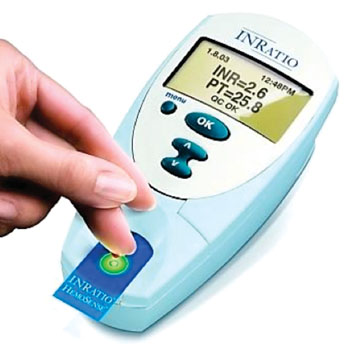Tests Used to Measure Internal Bleeding Possibly Unreliable
By LabMedica International staff writers
Posted on 10 Sep 2015
Internal bleeding may be uncommon as a result of taking blood thinners, but the normal coagulation tests physicians use to check for the side effect of bleeding may not be reliable.Posted on 10 Sep 2015
Oral anticoagulants are administered at fixed daily doses, without the need for laboratory-guided adjustments, but there are limited data available on supratherapeutic doses or overdose of the oral Xa inhibitors and recently the clinical effect in patients exposed to rivaroxaban and apixaban has been characterized.

Image: The point-of-care INRatio PT/INR monitor system (Photo courtesy of Alere).
Scientists at the Nationwide Children’s Hospital (Columbus, OH, USA) and their colleagues carried out a retrospective study and collected data from more than 800 hospitals and eight regional poison centers covering nine USA states. Data were collected on patients who contacted one of the participating poison centers between January 1, 2012, and December 31, 2014. Data were recorded at the occurrence of the case by trained specialists such as nurses, pharmacists, or physicians, during the routine management of the exposure.
Of the 223 patients involved in the study, bleeding was reported in only 15 (7%), and coagulation tests were normal in most patients with bleeding, prothrombin time (PT) 83%, partial thromboplastin time (PTT) 83%, and international normalized ratio (INR) 44%. The PT was shown to be elevated in volunteer studies with rivaroxaban and also elevated in massive overdose. However results of the PT after use of blood thinners varied with different components. The effects of medications on the PTT are short lived and varies based on the reagents used. In patients with bleeding, PT and PTT were elevated in one of four with rivaroxaban and none with apixaban.
In a single case with measured serum rivaroxaban concentration, the PT was recorded as 126.3 seconds. Without specific clarification of methodology and reagent use, the PT and PTT may not reliably predict risk of bleeding after rivaroxaban or apixaban ingestion. The INR was elevated in only 21% of patients tested with rivaroxaban and in no patients with apixaban. In patients with bleeding, the INR was elevated in five of eight with rivaroxaban but in none with apixaban. The use of activated clotting time also appears to be insensitive after the use Xa inhibitors.
Henry Spiller, D.ABAT, a toxicologist and coauthor of the study, said, “One way to overcome the variation in these tests is to use anti-factor Xa chromogenic assays to measure Xa plasma concentrations; however these are not widely available and a potential drawback with measuring anti-factor Xa concentrations and plasma rivaroxaban and apixaban concentrations is that the turnaround time for results may be too long to guide a treatment plan.” The study was published on August 24, 2015, in the Annals of Emergency Medicine.
Related Links:
Nationwide Children’s Hospital














